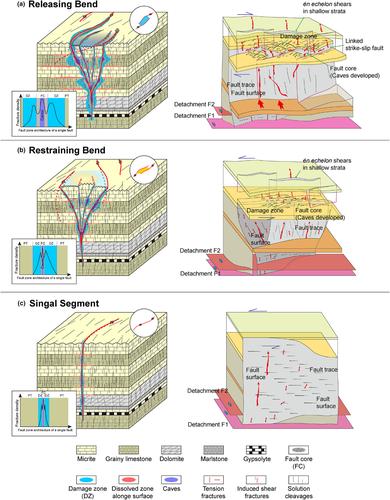当前位置:
X-MOL 学术
›
Basin Res.
›
论文详情
Our official English website, www.x-mol.net, welcomes your feedback! (Note: you will need to create a separate account there.)
Strike‐slip fault zone architecture and its effect on fluid migration in deep‐seated strata: Insights from the Central Tarim Basin
Basin Research ( IF 3.2 ) Pub Date : 2024-05-14 , DOI: 10.1111/bre.12868 Yin Liu 1, 2 , John Suppe 3 , Yingchang Cao 1, 2 , Kongyou Wu 1 , Jian Wang 1, 2 , Yannan Du 1 , Yujie Liu 1 , Zicheng Cao 4
Basin Research ( IF 3.2 ) Pub Date : 2024-05-14 , DOI: 10.1111/bre.12868 Yin Liu 1, 2 , John Suppe 3 , Yingchang Cao 1, 2 , Kongyou Wu 1 , Jian Wang 1, 2 , Yannan Du 1 , Yujie Liu 1 , Zicheng Cao 4
Affiliation

|
The internal fault architecture is crucial in assessing the significance of faults in fluid migration. The development of overlapping zones between segments and subsidiary structures is characteristic of a strike–slip faults. However, their internal architectures and roles in fluid migration are still poorly understood. The Tarim Basin's recently identified strike–slip faults imply that the petroleum resource is hosted in caves that were formed by subsequent dissolution after the formation of the fault zones in carbonate rocks, indicating that the internal fault architecture may be closely linked to the accumulation of petroleum. We investigated the architecture of the strike–slip fault zone using field, geochemical, seismic and well‐logging data. The results revealed that the strike–slip faults contain flower‐like structures in their vertical profiles and an en échelon and ‘X’ conjugate pattern in their horizontal slices. The fault core may become more complex because of the flower structure as fault breccia, slip surfaces, hydrothermal veins, dissolved pores and caves develop, and the damage zone contains multiple stages of fractures with high dip angles. Compared with ‘X’ pattern conjugate faults, NE‐trending strike–slip faults have a more developed and connected fault zone. The fault core acts as a fast conduit for fluid transport and experiences significant elemental losses, and the elemental variations in the damage zone may relate in long‐term and relatively lower‐level fluid–rock interactions. Three fault zone architecture models were created, namely, a releasing bend, a restraining bend and a single segment, and their controlling impacts on fluid migration were addressed accordingly. Our findings imply that fluid migration and accumulation are more favourable at the releasing bend than at the restraining bend and single segment.
中文翻译:

走滑断裂带结构及其对深层地层流体运移的影响——来自塔里木盆地中部的见解
内部断层结构对于评估断层在流体运移中的重要性至关重要。分段和附属构造之间重叠带的发育是走滑断层的特征。然而,它们的内部结构和在流体迁移中的作用仍然知之甚少。塔里木盆地最近发现的走滑断层意味着石油资源赋存于碳酸盐岩断层带形成后溶蚀作用形成的洞穴中,表明内部断层结构可能与石油聚集密切相关。 。我们利用现场、地球化学、地震和测井数据研究了走滑断层带的结构。结果表明,走滑断层在其垂直剖面上含有花状结构,并且梯队 和水平切片中的“X”共轭图案。由于断层角砾、滑动面、热液脉、溶孔、溶洞发育等花状结构,断层核可能变得更加复杂,破坏带包含多期高倾角裂缝。与“X”型共轭断层相比,NE向走滑断层的断裂带更为发育和连通。断层核充当流体输送的快速通道,经历显着的元素损失,损伤区的元素变化可能与长期且相对较低水平的流体-岩石相互作用有关。建立了释放弯、约束弯和单段三种断裂带构型模型,并分别探讨了它们对流体运移的控制作用。我们的研究结果表明,在释放弯道处比在限制弯道和单段处更有利于流体运移和积聚。
更新日期:2024-05-14
中文翻译:

走滑断裂带结构及其对深层地层流体运移的影响——来自塔里木盆地中部的见解
内部断层结构对于评估断层在流体运移中的重要性至关重要。分段和附属构造之间重叠带的发育是走滑断层的特征。然而,它们的内部结构和在流体迁移中的作用仍然知之甚少。塔里木盆地最近发现的走滑断层意味着石油资源赋存于碳酸盐岩断层带形成后溶蚀作用形成的洞穴中,表明内部断层结构可能与石油聚集密切相关。 。我们利用现场、地球化学、地震和测井数据研究了走滑断层带的结构。结果表明,走滑断层在其垂直剖面上含有花状结构,并且































 京公网安备 11010802027423号
京公网安备 11010802027423号